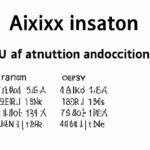The calculation of the Atkinson index is a method used to measure income inequality within a given population. It provides valuable insights into the distribution of income and the disparity between different groups. The Atkinson index takes into account both the unequal distribution of income and society’s level of aversion to inequality. By incorporating these factors, the index offers a comprehensive assessment of inequality. This calculation involves a mathematical formula that considers the income shares of individuals at different percentile levels. By analyzing the Atkinson index, policymakers and researchers can gain a deeper understanding of income disparities and work towards implementing policies to address them.
(Atkinson Index)
The Atkinson index is a measure of income inequality that takes into account the distributional aspects of an economy. It was developed by economist Anthony B. Atkinson in the early 1970s as a way to capture the extent of inequality within a society. The calculation of the Atkinson index involves three key steps. First, the income distribution is ranked from lowest to highest, with the lowest income being assigned a rank of 1, the second lowest a rank of 2, and so on. Second, a parameter, denoted by epsilon (ε), is chosen to represent the society’s level of inequality aversion. This parameter determines the weight given to different parts of the income distribution in the calculation of the index. A higher value of epsilon implies greater inequality aversion. Finally, the Atkinson index is calculated using the following formula: A = 1 – (1/L)*(∑(i=1) to L)((X_i / M)^1-ε) where A is the Atkinson index, L is the total number of individuals in the income distribution, X_i is the income of individual i, and M is the mean income of the entire population. The index ranges from 0 to 1, with 0 indicating perfect equality (i.e., everyone has the same income) and 1 indicating maximum inequality (i.e., one individual has all the income). A higher value of the Atkinson index suggests a higher level of income inequality. By calculating the Atkinson index, policymakers and researchers can gain insights into the distributional aspects of income inequality and potentially design policies to address the issue. However, it is important to note that the Atkinson index is just one of many measures available to capture income inequality, and its interpretation should be done in conjunction with other indicators to get a comprehensive understanding of the situation.Definition of Atkinson index
The Atkinson index is a measure used to assess income inequality within a population. It provides a numerical representation of the distribution of income, highlighting the level of disparity between various income groups. Unlike other commonly used indices, such as the Gini coefficient, the Atkinson index takes into account not only the relative incomes of individuals but also their level of aversion to inequality. The basic concept behind the Atkinson index is that people have different preferences regarding income inequality. Some individuals may be more tolerant of disparities, while others may strongly oppose any form of inequality. The Atkinson index incorporates this dimension of individual preferences by utilizing a parameter known as the inequality aversion parameter, often denoted as ε. Mathematically, the Atkinson index can be expressed as follows: A(x, ε) = 1 – [∑((xi / M)^ε)] / n where: A(x, ε) represents the Atkinson index x represents the income distribution ε represents the inequality aversion parameter n represents the number of individuals in the population xi represents the income of the ith individual M represents the mean income of the population The inequality aversion parameter, ε, plays a crucial role in determining the conclusion drawn from the Atkinson index. A larger ε value indicates a higher aversion to inequality, resulting in a more severe assessment of income disparity. On the other hand, a smaller ε value implies a lower aversion to inequality, yielding a less stringent portrayal of income distribution. In practical terms, the Atkinson index ranges from 0 to 1. A value of 0 signifies perfect income equality, indicating that all individuals possess the same income. Conversely, a value of 1 implies extreme income inequality, where a single individual possesses all the income. By utilizing the Atkinson index, policymakers, economists, and social scientists gain insights into the level of income inequality in a society and can evaluate the effectiveness of various policies aimed at reducing disparities. It enables decision-makers to identify income distribution patterns, evaluate the impact of tax policies or welfare programs, and formulate strategies to promote more equitable income distribution. However, it is important to note that the interpretation of the Atkinson index should be done cautiously, as the assessment of income inequality is influenced by the choice of the inequality aversion parameter, ε. Different parameter values can yield varying results, leading to differing conclusions about the level of income inequality within a population. In summary, the Atkinson index is a useful tool for measuring income inequality by incorporating individual preferences for equality. By considering the inequality aversion parameter, it provides a comprehensive assessment of income distribution, allowing policymakers to make informed decisions aimed at reducing disparities and promoting more equitable economic outcomes.
Factors affecting Atkinson index
The Atkinson index is a commonly used measure of income inequality that takes into account both the distribution of income and individuals’ relative welfare. It helps us understand the extent to which income distribution is unequal within a population. Several factors influence the Atkinson index, and understanding these factors is crucial in assessing income inequality. Let’s delve into the key factors that affect the Atkinson index. 1. Income dispersion: The Atkinson index is influenced by the extent to which income is dispersed across individuals. Higher income dispersion leads to a higher Atkinson index, indicating greater income inequality. Conversely, lower income dispersion results in a lower Atkinson index, suggesting a more equal distribution of income. 2. Income redistribution policies: Policies aimed at redistributing income, such as progressive taxation, social welfare programs, and minimum wage laws, have a significant impact on the Atkinson index. These policies help reduce income inequality, resulting in a lower Atkinson index. Conversely, limited or ineffective income redistribution efforts can lead to higher income inequality and, consequently, a higher Atkinson index. 3. Economic growth: Economic growth plays a vital role in determining income inequality and, consequently, the Atkinson index. In general, rapid economic growth tends to reduce income inequality as it provides opportunities for upward mobility and higher incomes for all segments of society. Conversely, slow or unequal economic growth can exacerbate income inequality, resulting in a higher Atkinson index. 4. Education and skills: The level of education and skill attainment among individuals has a significant impact on income inequality. Higher education and skill levels generally lead to higher incomes, reducing income inequality and lowering the Atkinson index. In contrast, limited access to education and skills training can perpetuate income disparities and result in a higher Atkinson index. 5. Gender and social factors: Gender and social factors, such as discrimination, societal norms, and access to resources, contribute to income inequality and influence the Atkinson index. Gender wage gaps, for instance, contribute to higher income inequality and a higher Atkinson index. Similarly, social barriers and unequal access to resources can perpetuate income disparities and increase the Atkinson index. 6. Globalization and technological advancements: Globalization and technological advancements have both positive and negative implications for income inequality. While they can create new economic opportunities and increase overall income levels, they can also exacerbate income disparities, particularly for low-skilled workers. The impact of globalization and technological advancements on the Atkinson index largely depends on how these trends are managed and whether appropriate policies are in place to ensure equitable distribution of benefits. Understanding these factors that affect the Atkinson index is crucial in assessing income inequality and formulating policy interventions. By addressing income dispersion, implementing effective income redistribution policies, promoting inclusive economic growth, improving access to education and skills training, addressing gender and social disparities, and managing the impact of globalization and technological advancements, it is possible to reduce income inequality and work towards a more equitable society.
Formula for calculating Atkinson index
The Atkinson index is an economic measure used to quantify income inequality within a given population. It was proposed by economist Anthony Barnes Atkinson and provides a numerical representation of the income distribution among individuals or households. Understanding the formula for calculating the Atkinson index is essential to accurately assess and analyze income inequality. The Atkinson index measures inequality by considering the extent to which individuals are willing to make trade-offs between income equality and overall income level. It takes into account the distribution of income and the societal value placed on income disparities. The formula for calculating the Atkinson index is as follows: A = 1 – (1/n) * ∑[1 – (xi/Y)^e] In this formula, A represents the Atkinson index, n represents the number of individuals or households in the population, xi represents the income for each individual or household, Y represents the mean income of the population, and e is a parameter that measures the societal value placed on income disparities. The formula calculates the average income shortfall that individuals or households in the population experience due to income inequality. It does this by summing up the income shortfall for each individual or household (1 – (xi/Y)^e), raising it to the power of e, and then subtracting the result from 1. The resulting value is the Atkinson index, which ranges from 0 to 1. A value of 0 indicates perfect income equality, meaning that all individuals or households in the population have the same income. Conversely, a value of 1 indicates complete income inequality, where one individual or household possesses all the income, and none is shared by others. The parameter e in the formula plays a crucial role in determining how income disparities are valued in society. It represents the societal aversion towards inequality, with higher values indicating a higher level of aversion. Different values of e can be used to reflect different societal preferences regarding income distribution. For example, if e is set to 0, the formula reduces to a simple average of the income ratios, while larger values of e will magnify the contribution of higher incomes to the overall index. In conclusion, the formula for calculating the Atkinson index provides a comprehensive measure of income inequality within a population. By considering both the income distribution and the societal value placed on income disparities, it allows economists and policymakers to gain insight into the level of income inequality and make informed decisions to address it.
Interpretation of Atkinson index
The interpretation of the Atkinson index is crucial in understanding and analyzing income inequality within a particular population. This index, named after economist Anthony B. Atkinson, measures the magnitude and distribution of economic inequality by considering the deviation from an equal distribution of income or wealth. The Atkinson index ranges between zero and one, with zero indicating perfect equality, where everyone in the population possesses the same amount of income or wealth. Conversely, a value of one signifies maximum inequality, where one individual holds all the income or wealth, and the remaining population has none. The interpretation of the Atkinson index can be broken down into three levels: 1) low inequality, 2) moderate inequality, and 3) high inequality. In the case of low inequality, a value close to zero indicates a society with relatively equal distribution of income or wealth. This suggests that the population has a fair and balanced income or wealth distribution, where no one individual or group has a significantly higher or lower share. In such cases, the Atkinson index implies a state of economic harmony and suggests a minimal need for redistribution policies. In cases of moderate inequality, the Atkinson index falls between zero and one but is closer to zero. This indicates that while some income or wealth disparities exist among individuals, the overall distribution is relatively equitable. Moderate inequality can occur due to factors such as differences in education, skills, or work experience, which lead to varying levels of income but within a reasonable range. In this scenario, policymakers might consider implementing policies to address the disparities but on a smaller scale compared to cases of high inequality. On the other hand, high inequality manifests when the Atkinson index is close to or equal to one. This suggests a vast concentration of income or wealth in the hands of a few individuals, while the majority struggle to meet basic needs. High inequality poses significant socioeconomic challenges, including reduced social mobility, increased poverty rates, and decreased overall economic efficiency. In this context, policymakers may need to adopt redistributive measures, such as tax reforms, welfare programs, or comprehensive education and healthcare initiatives, to address the unequal distribution and promote a more inclusive society. The interpretation of the Atkinson index aids policymakers, economists, and researchers in developing effective strategies to tackle income or wealth inequality. By understanding the degree and nature of inequality within a population, policymakers can craft targeted policies and interventions to promote a fairer distribution of resources and enhance overall socio-economic welfare. To conclude, the interpretation of the Atkinson index provides valuable insights into the level of income or wealth inequality within a population. Whether indicating low, moderate, or high inequality, policymakers can craft appropriate policies to promote economic fairness and inclusivity, thus ensuring a better future for all.
Limitations of Atkinson index
The Atkinson index is a measure used to assess income inequality within a society. While it can provide valuable insights, it also has some limitations that need to be considered when using it as a tool for analysis. Here are some of the limitations of the Atkinson index: Firstly, the Atkinson index only considers inequality in income distribution and it does not take into account other important dimensions of well-being such as education, health, or access to basic services. As a result, it may not provide a comprehensive picture of overall inequality within a society. Secondly, the Atkinson index is based on the assumption that individuals are solely concerned about their own incomes, rather than their relative incomes compared to others. This means that it does not capture the impact of social comparisons or relative deprivation on inequality. Individuals may be more concerned about their position relative to others, rather than the absolute level of their own income. Thirdly, the Atkinson index is sensitive to changes in the distribution of incomes at the lower end of the income scale, but less sensitive to changes at the higher end. This means that it may not accurately capture changes in inequality if there are significant shifts in income distribution among higher earners. Another limitation is that the Atkinson index does not consider differences in the population size or demographic composition when measuring inequality. This means that it may not accurately reflect the actual level of inequality if there are significant differences in the population size or composition between different regions or groups within a society. Additionally, the Atkinson index assumes that all individuals have equal utility functions, meaning that each person’s satisfaction or well-being is equally influenced by changes in income. However, in reality, people have different preferences and priorities, making it difficult to accurately capture the subjective well-being associated with different income distributions. Lastly, the Atkinson index is a summary measure that provides a single number to represent income inequality. While this can be useful for comparisons between different societies or over time, it may oversimplify the complex nature of inequality within a society. Different aspects and dimensions of inequality may require the use of additional measures to gain a more nuanced understanding. Overall, while the Atkinson index can provide valuable insights into income inequality, it is important to be aware of its limitations. It is advisable to use it in conjunction with other measures and consider additional dimensions of well-being to attain a more comprehensive assessment of inequality within a society.













